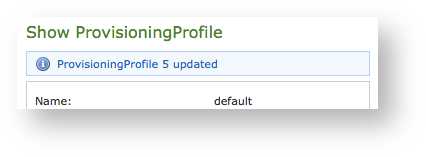1. Provisioning profile
Provisioning profile is a PrivateGSM configuration template, that can be re-used across different VoIP accounts. It is possible to create different provisioning profile, depending on organization and groups of users.
Provisioning profile can be assigned to a group, as a default profile for all VoIP account in that group. It is possible to assign a provisioning profile to a specific VoIP account, overriding the group configuration.
CSR can select and assign a specific provisioning profile.
By default the appliance comes with a default provisioning profile (shown in figure 1. default provisioning profile).
2. Create a new provisioning profile
In order to create a new provisioning profile you have to press the "New ProvisioningProfile" button and get a new profile form as below:
2.1.1.1. Options useful for customer support
Most of the field can be left as by default. You probably need to fill:
- Customer Service Phone: number to be called to reach the customer service
- Customer Service Email: email that will receive the logs and the complaints about the issues
- Logging: it's not mandatory but still very suggested to enable the logging in the clients for possible troubleshooting analysis
- Read only settings: very handy to keep the application control. This wouldn't let the user to change the settings by his/hers own.
2.1.1.2. BlackBerry specific options
Blackberry devices require some specific configuration to work, especially the transport type to be used for the always-on connection used by signaling traffic (SIP over TLS):
- BES: this transport routes your traffic through RIM servers around the world.
- BIS-B: this transport routes your traffic through RIM servers around the world.
- Direct-TCP: this is usual internet access option used on all other smartphone platforms, using internet APN.
We strongly suggest to use Direct-TCP transport, both for privacy and performances reasons:
- Privacy: signaling traffic is encrypted, that means that nobody can know who you called, but it is still possible to detect when you had a secure call. If you select Direct-TCP, your mobile operator or an attacker sniffing your traffic could know it. If you select BES or BIS-B also RIM can know this information
- Performances: RIM network (BES and BIS-B) is an overlay network, which add both latency and quality issues over your mobile operator network. It is still memorable the RIM server failure happened on October 2011, with one week outage
APN configuration is mandatory, whichever transport you choose:
- BES and BIS-B transport cannot route UDP traffic used during secure call
- Direct-TCP: APN configured here will be used only by PrivateGSM client, not by other installed applications
2.1.1.3. Secure Messaging option
- Enable Messaging: enables Secure Messaging feature on PrivateGSM.
By default this option is NOT set.
If you want your customers to use this feature then you are obliged to check the above option and then you have to provision the new configuration to all the interested clients.
2.1.1.4. Privacy options
- User can edit history log size: if checked, then customers can change theirs History log size. History is a new way of grouping events occurred on the client, both Secure Calls and Secure Messages. Thus it's an important privacy subject how many events can stay in the History list.
- History log size: In case users were not able to set their history size it could be convenient to decide a maximum amount of events to be shown client side. This option is where you can take this decision. Please consider that default value is 50 events per user.
As History groups events by the contact's numbers they occurred to, then History size number is to be meant as per contact's number. Eg: if there's a 50 events value set in History log size, each contact listed in History can show up to 50 events. 10 contacts who had events with a customer then create 500 (50 max events list * 10 contacts) history log lines, all grouped by contact's number.
Once you completed to fill the form you can proceed with the profile creation just pressing the "Create" button at the bottom.
3. Edit a provisioning profile
From the Provisioning Profile list, choose the profile you need to edit and click on it with your mouse. the "Show Provisioning Profile" page will appear (see figure 3. new provisioning profile created).
Press the "Edit" button.
Change the fields you need to and when you're done press the "Update" button at the bottom of the form to save the changes.
4. Delete a Provisioning Profile
By the very same form shown above in figure 3. new provisioning profile created you can also delete your Provisioning Profile.
You have to click on the "Delete" button and Confirm the operation by clicking "Ok" in the warning pop-up window. The Profile should be gone.



